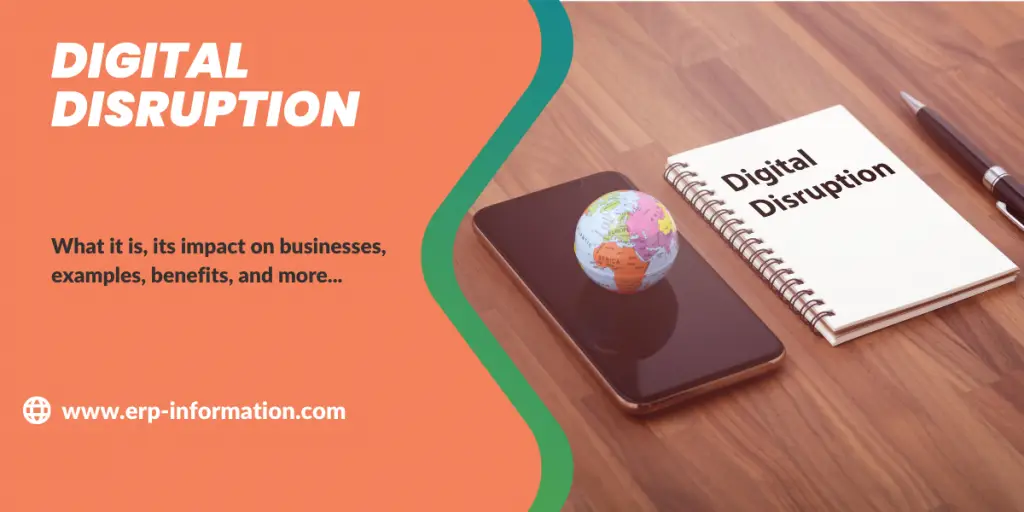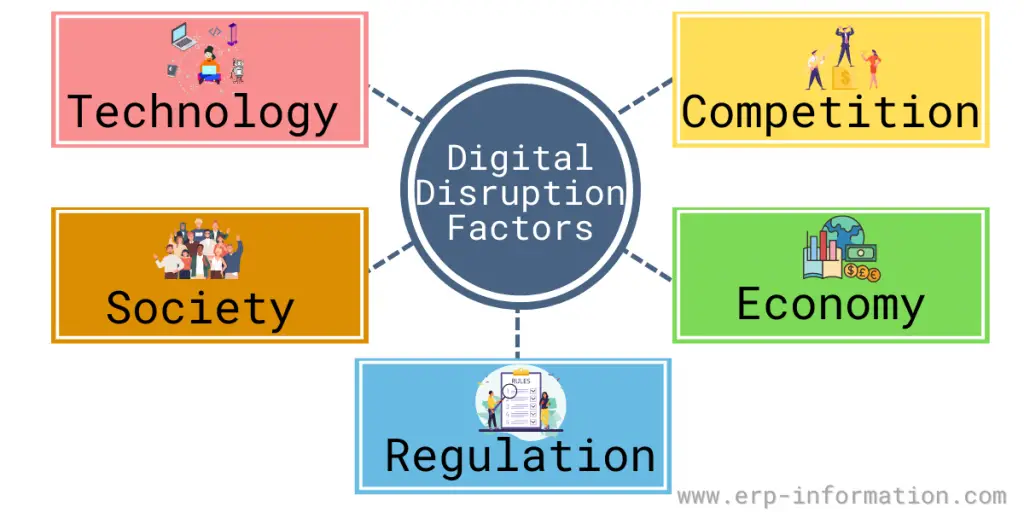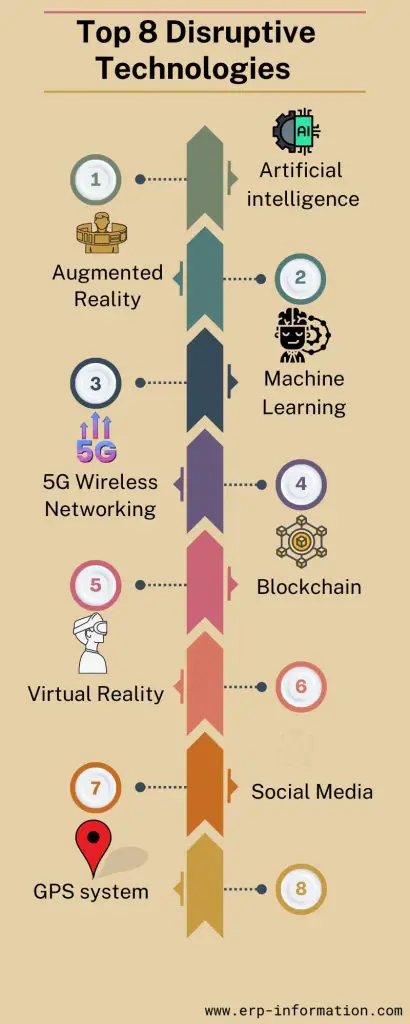In simplest terms, digital disruption is a company’s disruption by digital technologies such as big data and machine learning.
That can come from new startups or established businesses forced to change their business models because of technological advancements. Technologies and business models are the main areas of digital disruption.
The impact of digital disruption can be felt in several industries, and it is something that all businesses need to be aware of.
This article discloses digital disruption, its importance, benefits, examples, factors, disruptive technologies, and how it impacts industries and businesses.
Let us see the Digital Disruption Definition.
What is Digital Disruption?
Digital disruption is the term given to the phenomenon of technological change and innovation disrupting existing business models. It can refer to changes in how businesses operate or customers interact with them.
It is like a storm of change in the business world. It happens when new digital technologies and clever ways of doing things shake up how companies work. Imagine it as a giant wave that can turn things upside down.
In other words, It is a term used to express the impact of digital technologies on industries, businesses, and individuals. These technologies can potentially disrupt traditional business models and create new opportunities for businesses.
This disruption can manifest in various forms, such as the introduction of new digital products and services, innovative distribution channels, or more efficient operational processes. It fundamentally alters the way customers interact with a business and their expectations.
Those who successfully navigate and leverage digital disruption can gain a significant competitive edge, while those who resist or ignore it face the risk of being left behind.
Importance
This is essential because it can completely change how a business operates. Unfortunately, many businesses are unaware of its potential impact and are at risk of being disrupted.
Digital disruption signals businesses that customers’ requirements are changing. Hence the business must understand and accept the interruption. Otherwise, there will be a chance of going bankrupt.
For example, Blockbuster was once the leading video rental company, but it failed to adapt to the digital age and went bankrupt. Kodak was also a leading camera manufacturer, but it failed to embrace digital photography and went bankrupt.
Businesses that can adapt to digital disruption can reap significant rewards. For example, Amazon disrupted the retail industry by offering a convenient shopping experience.
Uber didn’t exist until 2009, and Airbnb was founded in 2008. These companies disrupted the traditional taxi and hotel industries by offering a more convenient and affordable service.
Digital Disruption Examples
Let us look into some real-world examples.
- The music industry was disrupted by the advent of digital streaming services such as Spotify and Apple Music. These services enable users to listen to music online without purchasing or downloading songs. This disrupted the music industry’s new business models, which relied on consumers buying albums.
- The taxi industry has been disrupted by services like Uber and Lyft, which allow people to hail a ride using their smartphones.
- The hotel industry has been disrupted by services like Airbnb, which allow people to book a room in someone’s house or apartment.
- The retail industry has been disrupted by online shopping. Digital technology has allowed customers to purchase items online without going through a physical store. That has led to the decline of many traditional retail businesses.
The list goes on. New Digital technologies have disrupted many industries, and many businesses have had to adapt or face extinction.
Unfortunately, digital disruption will not slow down anytime soon, so businesses must be prepared for the changes it will bring.
Benefits of Digital Disruption
Increased Efficiency
It helps businesses to run more efficiently and effectively. For example, with a CRM like Hubspot, businesses can manage all their customer data in one place.
Greater Connectivity
With technologies, businesses can connect with customers and partners in new ways. For example, businesses can reach a global audience through online marketing and social media platforms.
New Markets and Opportunities
It creates opportunities for businesses to enter new markets or tap into new segments. Increased digital capabilities will create more product demand in the market.
Increased Innovation
It leads to increased innovation as companies compete to offer the best products and services.
Reduced Costs
It reduces costs as companies find ways to do things more cheaply and efficiently.
Drawbacks
- Losing customers who are not comfortable with or do not understand new technology
- Difficulty in adapting to changes and keeping up with the latest trends
- Increased competition from businesses that can utilize new technology more effectively
- Falling behind technologically and losing out on potential advancements
- Lower customer satisfaction due to glitches and technical difficulties
- It can lead to massive job losses as companies automate or eliminate positions.
Digital Disruption Factors
Factors are the triggers or causes of digital disruption. Five main factors can cause a business to be disrupted: technology, society, regulation, economy, and competition.
Each of these factors can have a ripple effect on the others, creating a perfect storm for a business to be disrupted.
Technology
New technologies or digital transformation can create opportunities for businesses to disrupt their competitors. For example, Uber used mobile device technology to create a ride-sharing service that disrupted the taxi industry.
Similarly, Airbnb used online platforms to create a home-sharing service that disrupted the hotel industry. This is a disruptive technology in the hotel industry.
Society
Changes in society, such as the rise of the sharing economy, can create opportunities for businesses to disrupt their competitors.
In addition, changes in societal values can impact businesses. For example, people have been aware of sustainability and environmentalism recently.
That has led to increased demand for sustainable products and services, creating opportunities for businesses to disrupt their competitors.
Regulation
New regulations can create opportunities for businesses to disrupt their competitors. For example, introducing new data protection regulations in Europe has increased demand for data privacy services, creating opportunities for industries such as Crypterium and Dataplorations to disrupt the data privacy market.
Economy
Changes in the economy can create opportunities for businesses from disruptive technology to their competitors.
For example, the global financial crisis in 2008 increased the demand for affordable housing, creating business opportunities.
Competition
Increased competition can lead to disruptive innovations as companies try to differentiate themselves from their competitors to reach customer expectations.
For example, when Netflix first launched its streaming service in 2007, it competed against video rental companies such as Blockbuster.
Netflix differentiated itself from Blockbuster by offering its service at a lower price and offering its customers more flexibility regarding how they could watch their movies. That led to Netflix disrupting the video rental industry.
Top 8 Disruptive Technologies of 2024
1. Artificial intelligence
Artificial Intelligence (AI) technology allows machines to carry out tasks that usually need human intelligence. By imitating cognitive functions like reasoning, learning, and problem-solving, AI is transforming numerous industries and improving our everyday experiences. Examples are
- Robots
- Retail chatbots
- Facial recognition technology
- Self-driving cars
2. Augmented Reality
With AR, users can see digital information overlaid on the physical world. This new technology is already being used in some industries, including healthcare, manufacturing, and education.
For example, surgeons can use AR to view live images of a patient’s organs during surgery. Manufacturers can use AR to view digital instructions while assembling products. And teachers can use AR to create immersive learning experiences for students.
3. Machine Learning
This new digital technology enables computers to learn on their own by analyzing data. As a result, machine learning can be used for various purposes, such as improving search results, detecting fraud, and predicting consumer behavior.
Machine learning can improve operational efficiency, reduce costs, and create new revenue opportunities in the business world.
4. 5G Wireless Networking
This technology promises faster data speeds and greater bandwidth than current wireless networks. As a result, 5G will be instrumental in enabling next-generation technologies such as augmented reality and autonomous vehicles.
It will also allow businesses to stream video content more efficiently and provide real-time services such as remote surgery and banking.
5. Blockchain
Blockchain is a disruptive technology expected to have a significant impact in 2024. With blockchain, businesses can make secure, transparent, and tamper-proof transactions between two or more parties.
As a result, it has revolutionized many industries, including financial services, healthcare, and SCM. For example, blockchain could securely track medical records or the provenance of goods throughout the supply chain.
6. Virtual Reality
VR allows users to experience digital worlds realistically. This technology is already used for gaming, entertainment, and training.
VR can be used in business for product design, marketing, and employee training. For example, companies can use VR to give employees realistic training experiences or to create immersive product demonstrations for potential customers.
7. Social Media
Social media platforms have significantly transformed how businesses operate. It offers an efficient and straightforward method to reach a vast audience.
These platforms enable companies to connect with their customers, foster relationships, and establish a strong brand identity. Social media is an excellent platform for marketing and advertising, allowing businesses to engage directly with their target market.
8. GPS System
GPS systems help to determine the location of a person or an object accurately and use satellite technology to do this work. This innovation has revolutionized traditional navigation methods, which primarily relied on paper maps.
The technology is advantageous for businesses as it enhances operations through the provision of real-time data. Additionally, companies can utilize GPS systems for marketing by directing advertisements to individuals based on their current location.
FAQs
How do you know if the technology is disruptive?
There are essentially two paths: sustaining and disruptive. When your innovation tweaks the existing product, making it a bit better, it falls into the sustaining category.
However, if your innovation completely revolutionizes how the product is used, or it opens the door to a whole new group of customers, then you’ve ventured into the realm of disruptive innovation.
In a nutshell, sustaining keeps things on track, while disruptive turns the track into a whole new highway.
What is the main concern of disruptive innovation?
The primary concern with disruptive innovations is that they often don’t seem very profitable or promising when they’re brand new. Market leaders might hesitate to invest in them because these innovations can take resources away from improving their existing products (sustaining innovations).
This could put their current competitive edge at risk. So, the challenge is balancing the need to stay competitive now with the potential for future change brought by disruptive ideas.
Conclusion
Digital disruption has had a vast impact on industries and businesses across the globe. Technologies and business models play major roles in digital disruption. It can not be easy to keep up with the latest changes, but those who can adapt often reap the benefits.
In this article, we’ve outlined what digital disruption is and how it impacts businesses. We also shared examples of how companies have been affected by digital disruptions in their respective industries.


